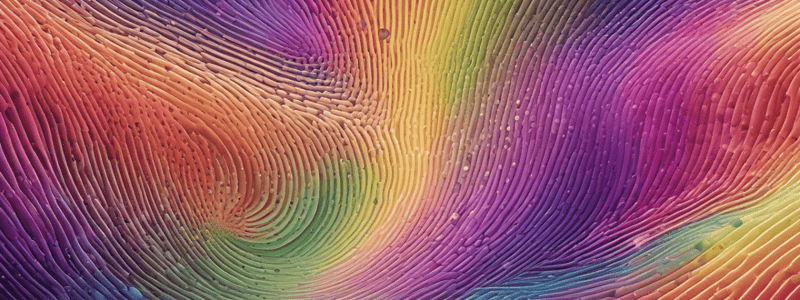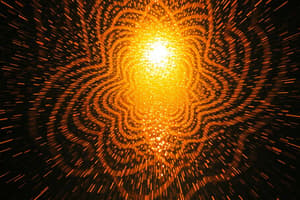Podcast
Questions and Answers
What shape should the slits be attached in?
What shape should the slits be attached in?
- Horizontal line
- V-shape (correct)
- Circle
- Straight line
What is the maximum width of the slit recommended for this experiment?
What is the maximum width of the slit recommended for this experiment?
- 2 millimeters
- 0.5 millimeter
- 3 millimeters
- 1 millimeter (correct)
What effect should be observed on the screen after shining the laser beam through the slit?
What effect should be observed on the screen after shining the laser beam through the slit?
- A single dark spot
- No pattern at all
- A uniform bright light
- A bright area with alternating dark and light bands (correct)
What happens to the pattern on the screen as the slit width is increased?
What happens to the pattern on the screen as the slit width is increased?
What is the relationship between slit width and light diffraction?
What is the relationship between slit width and light diffraction?
How does the brightness of the light bands change with varying slit widths?
How does the brightness of the light bands change with varying slit widths?
What should be done to adjust the aim of the laser pointer during the experiment?
What should be done to adjust the aim of the laser pointer during the experiment?
What is observed when the laser is moved from thinner to wider slit widths?
What is observed when the laser is moved from thinner to wider slit widths?
What materials are suggested for supporting the laser pointer during the experiment?
What materials are suggested for supporting the laser pointer during the experiment?
What effect does widening the gap of the slit have on the light passing through?
What effect does widening the gap of the slit have on the light passing through?
What process describes the spreading out of light as it passes through an aperture?
What process describes the spreading out of light as it passes through an aperture?
What condition is necessary for diffraction to occur?
What condition is necessary for diffraction to occur?
In an interference pattern, what creates the bright areas?
In an interference pattern, what creates the bright areas?
What happens during destructive interference?
What happens during destructive interference?
Which of the following is NOT necessary for the physics lab described?
Which of the following is NOT necessary for the physics lab described?
Which part of the laser diffraction setup is used to create the slit?
Which part of the laser diffraction setup is used to create the slit?
What type of pattern is produced by overlapping light waves?
What type of pattern is produced by overlapping light waves?
What is the role of the razor blade in the diffraction experiment?
What is the role of the razor blade in the diffraction experiment?
Which of the following best describes the result of constructive interference?
Which of the following best describes the result of constructive interference?
What is the purpose of cutting the razor blade length-wise?
What is the purpose of cutting the razor blade length-wise?
Flashcards are hidden until you start studying
Study Notes
Diffraction and Interference Overview
- Light behaves as a wave and can reflect, refract, diffract, and interfere.
- Diffraction is the spreading of light as it passes through an aperture or around an object, reliant on the aperture's size relative to the wavelength.
- Light's wavelength is small, making diffraction observable despite its minimal scale.
Interference Patterns
- Light waves can overlap, creating interference patterns of alternating light and dark regions.
- Constructive interference occurs when peaks or troughs of overlapping waves coincide, resulting in brighter regions.
- Destructive interference happens when a wave's peak meets another's trough, creating darker areas.
Physics Lab Setup
- Required materials for the diffraction lab include:
- Laser pointer
- Razor blade (cut in half)
- Clothes pins
- Slide frame
- Duct tape, scissors, and a screen or white wall.
- The razor blade halves are taped to the slide frame in a slight V-shape to create a narrow slit (~1mm wide).
Lab Procedure
- The laser beam is directed through the slit to observe the diffraction pattern on a screen.
- Adjustments to the laser pointer help visualize changes in the pattern on the screen.
Data Analysis Observations
- The resulting pattern shows a central bright area (central maximum) with alternating dark and light bands on either side.
- Smaller slit widths result in a wider diffraction pattern; larger widths yield narrower patterns.
- As the slit width increases, the intensity of the light and dark bands decreases due to less diffraction.
Studying That Suits You
Use AI to generate personalized quizzes and flashcards to suit your learning preferences.



